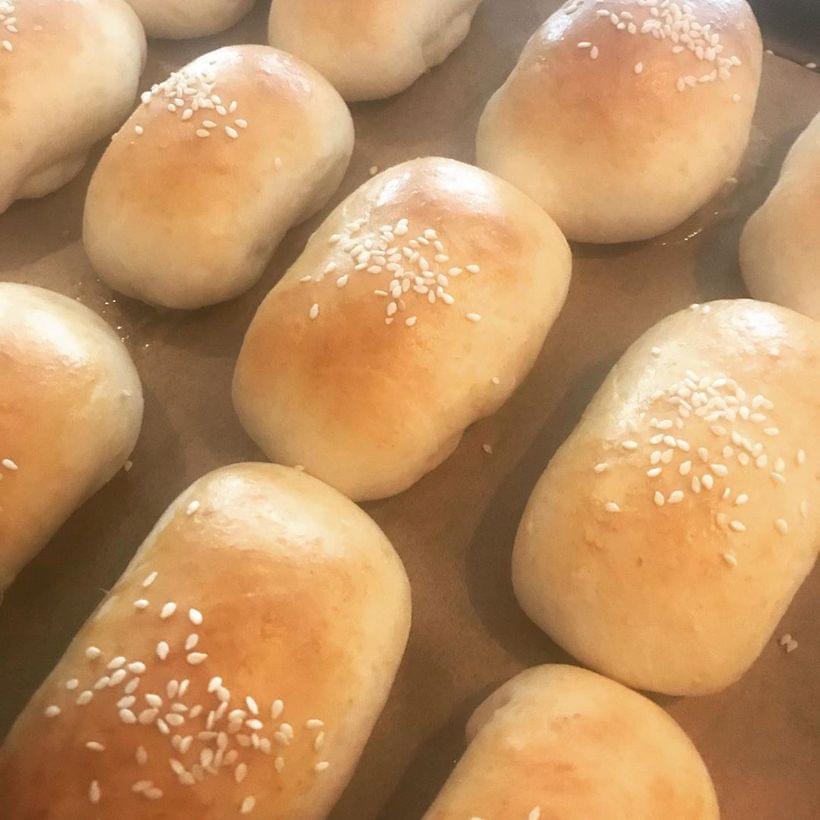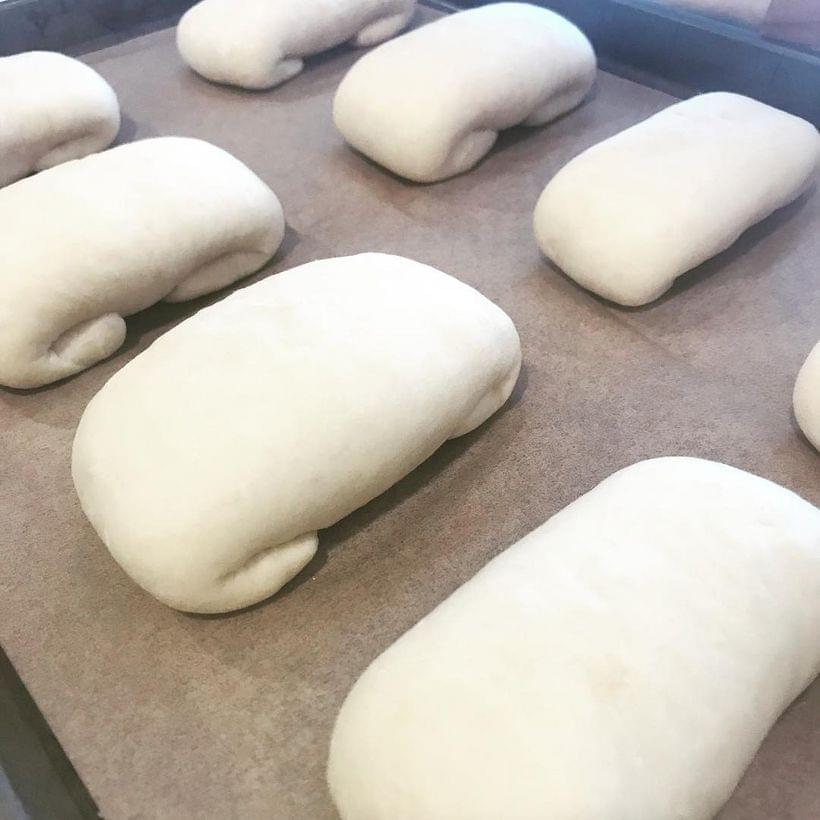Gai Mei Bao
Skip to the recipe
Today we’re making a sweet, pillowy dough, with a custardy coconut filling. Along the way, we’re gonna learn a highly advanced bread-making technique—and maybe, just maybe… a little something about ourselves?
No, we are almost certainly not going to learn anything about ourselves here. Not unless you’ve been taking a weirdly wait-and-see approach to your own coconut preference, up to this point. Also this “highly advanced bread-making technique” involves all of two ingredients and five minutes. The toughest part of it is having another pan to wash afterwards.
Said technique is a tangzhong, or in Japanese, yudane—sometimes “yukone.” For reasons we’ll get into in a bit, I’m gonna stick with “tangzhong” here.
It’s a roux made with water instead of a fat: mix flour and water, bring it to a simmer, it thickens to a paste, you’re done. Throw it in your bread.
What’s “tangzhong” for?
It’s a texture thing. There’s a pretty linear scale of “soft” to “chewy” with regular ol’ bread—more gluten means chewier, crustier bread; less means softer bread, in terms of both crust and crumb. Down near the less glutinous end of the spectrum, you don’t tend to get a particularly good bread, for the most part—not in the traditional sense. You get something flat in terms of both flavor and texture; not pillow-soft, like you might want from a buttery dinner roll or fluffy sandwich bread.

With a tangzhong, you’re gelatinizing the starches in the flour—causing them to swell, absorb water, and thicken—think “instant oatmeal.” For thickening things like sauces, stews, and curry rice, you’re using flour and butter—the butter contains enough water for the flour to absorb it, but the fat in the butter helps to keep the starch molecules separated, so they don’t clump up and leave you with a lumpy sauce. Without any fats in play, well, we’re just making one big lump of gelatinized starch, loaded with water.
Adding that blob of gelatin to a loaf of bread will make it more… toothsome, I guess, but not in a “chewy, crusty” way—not the way more gluten development would. You’re also adding more water in a way that keeps it from making your dough soggy—those broken-down starches are still hoarding it all, and even stealing some of the water from your final dough. All told, you get a high-hydration and pillowy soft—but still structurally sound—dough. As an added bonus, bread made using a tangzhong stay fresh longer—it won’t dry out and go stale as quickly.
The Ol’ Double Roux
We’re doin’ one with the filling, too, with butter and flour. The more water makes it into the filling, the greater the threat of our dough bursting open in the oven, from the steam. So, I’m starting the filling in a skillet to cook off some of the water and let things thicken up. It’s dry and crumbly once cooled, which makes it easier to work with when you’re wrapping these up. Roll out your dough, place a scoop of the cooled filling in the center, fold the dough over it so you have a cylinder, then pinch the ends and tuck them underneath to seal it up. I usually seal the seams dumpling-style, with a fingertip dipped in a little dish of water.
Bakers’ Fun-Fact Language Corner™
Disclaimer: I don’t know what I’m talking about.
That said: near as I can tell, the origin and name of this technique are both a little hand-wavy. It looks like—and I’m outta my depth here, for certain: “tangzhong” can be written as either 燙種 or 湯種, with both pronounced the same way.
燙種 seems to usually refer to an approach that feels a little like an autolyse, but using scalding hot water to start with—here’s an example. It makes a lot of sense, logistically: some of the starches in the flour gelatinize while the water is very hot, an autolyse kicks off once the water has cooled a little, and the temperature is right for adding the yeast once everything has cooled down a little more.
湯種 seems to refer to a more traditional approach to a roux: mix the water and flour, bring to a simmer, tons of gelatinization takes place, and the whole thing is added to the bread already in progress. It’s steppier, but more controlled, and seemingly more common, showing up in recipes as mainstream as Stella Parks’ bagel recipe.
Again, though, I have no idea what I’m talking about. So y’know, direct any and all corrections to the usual channels.
Recipe: Gai Mei Bao
Sweet, coconut-scented dough with a creamy coconut filling. Breakfast of champions, if you ask me.
Ingredients
Instructions Tangzhong
-
25 G. All-purpose flour
-
60 G. Water
Instructions Filling
-
6 Tbsp. Unsalted butter, melted
-
1/2 tsp. Vanilla extract
-
1/2 C. Granulated sugar
-
4 Tbsp. Dessicated coconut, unsweetened
-
4 Tbsp. All-purpose flour
-
A pinch Kosher salt
Instructions Final Dough
-
215 G. All-purpose flour
-
260 G. Bread flour
-
125 G. Water, between 90–100 degrees
-
80 G. Whole milk, between 90–100 degrees
-
1/2 tsp. Salt
-
80 G. Sugar
-
1 tsp. Malted milk powder
Optional -
21/4 tsp. Instant yeast
-
2 Tbsp. Coconut oil, unrefined
-
1 Egg, lightly beaten, for brushing
Instructions
Instructions For the Tangzhong (water roux)
Whisk 25G all-purpose flour and 60G water in a shallow skillet over medium heat, until a thick paste forms.
Spread the paste on a sheet of parchment, set aside, and allow to cool to room temperature.
Instructions For the Filling
Melt butter in a skillet over low-medium heat. Add flour and coconut and whisk to combine. Continue whisking constantly.
Cook, whisking constantly, until foaming and thickened to a custard-like consistency.
Once mixture has thickened and foaming has significantly subsided (~10 minutes), add sugar, salt, and vanilla extract.
Remove from heat once fully combined, and mixture has begun to look crumbly. Set aside, and allow to cool to room temperature.
Instructions For the Final Dough
In the bowl of a stand-mixer or large mixing bowl, bring together all of the final dough ingredients—minus the egg—including the cooled tangzhong. Add more water a teaspoon at a time, until the dough just comes together into a shaggy ball.
Switch to a dough hook and knead on low–medium speed for seven minutes, or hand-knead for ten minutes or so.
Remove dough to a clean, lightly oiled bowl, and allow to proof at room temperature for about an hour (or until roughly doubled in size).
Punch the dough down, knead lightly to deflate, and divide into sixteen equally-sized portions. Form into balls, cover loosely, and allow to rest for ten minutes.
On a lightly floured countertop, roll each ball out into an oval. Add about two teaspoons of filling in the center, then fold the dough onto itself like an envelope and move to a parchment-lined baking sheet, seam side down.
Cover and proof for half an hour. In the meantime, preheat your oven to 375 degrees Farenheit.
Brush with egg wash (I add about a teaspoon of water to the beaten egg, to make it brush a little more easily), optionally dust with sesame seeds, and bake for about fifteen minutes, or until golden brown.